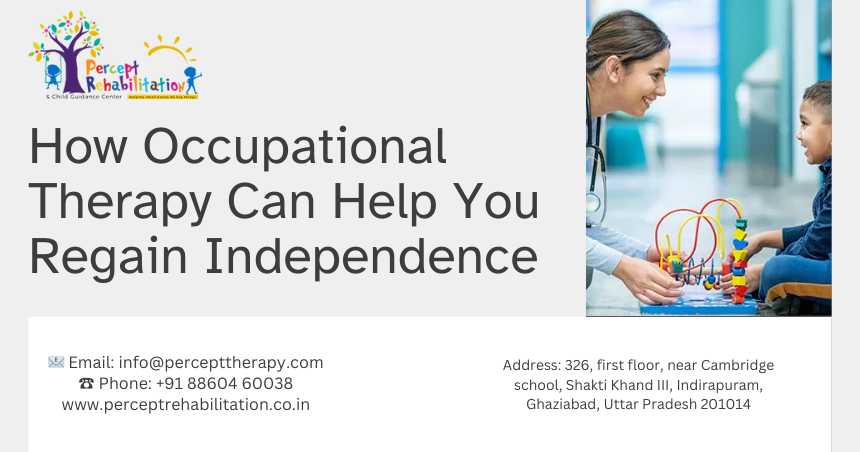Attention-Deficit/Hyperactivity Disorder (ADHD) is a neurodevelopmental condition that affects a child’s ability to focus, control impulses, and manage behavior appropriate to their age. For families in Indirapuram seeking a structured, evidence-based approach to support their children, finding the best occupational therapist in Indirapuram becomes a vital step toward long-term developmental success. Occupational Therapy (OT) plays a significant role in creating pathways for children with ADHD to build focus, emotional regulation, and self-confidence. At Percept Rehabilitation Centre, the emphasis is on tailoring therapy that fosters independence, enhances executive functioning, and promotes meaningful engagement in everyday tasks.
What is ADHD and How It Affects Functional Life?
ADHD is marked by symptoms that fall under two major categories: inattention and hyperactivity-impulsivity. While every child may occasionally be forgetful or restless, ADHD causes persistent challenges that interfere with daily activities, both at school and at home.
Common behaviors in children with ADHD include:
- Short attention span
- Easily distracted
- Trouble organizing tasks
- Frequent interruptions during conversations
- Impulsive decision-making
- Excessive physical movement or fidgeting
These challenges often affect academic performance, peer relationships, and emotional well-being. Occupational Therapy addresses these functional disruptions by focusing on developing adaptive skills in a structured, consistent manner.
Core Goals of Occupational Therapy in ADHD
Occupational Therapy is not about correcting the child, but rather about equipping them with tools and techniques that help them function optimally within their environment. It bridges the gap between developmental capabilities and real-world expectations.
Key goals include:
- Enhancing attention span and task completion
- Improving motor coordination and body awareness
- Strengthening executive functions such as memory and organization
- Building emotional regulation strategies
- Promoting independence in daily routines
- Facilitating better interaction with peers and adults
Occupational therapists at centers like Percept Rehabilitation Centre create personalized therapy programs that align these goals with the child’s unique challenges and strengths.
Sensory Processing and ADHD: A Crucial Link
A significant number of children with ADHD also face difficulties in sensory integration. This means they may be overly sensitive to certain stimuli (e.g., sounds, textures) or appear under-responsive, constantly seeking movement or touch to regulate themselves.
OT uses Sensory Integration Therapy (SIT) to help children modulate these sensory inputs effectively. Through targeted activities, therapists enable children to process sensory data in ways that support attention, behavior, and emotional stability.
For example:
- A child who constantly fidgets may benefit from heavy work activities like pushing weighted carts or climbing.
- A child sensitive to noise may work with noise-canceling headphones during focused tasks.
- Therapists may incorporate vestibular (movement-based) inputs such as swings or balance boards to build internal regulation.
How Occupational Therapists Evaluate ADHD in Children?
Evaluation is a cornerstone of effective intervention. A well-rounded assessment informs therapy goals, tracks progress, and ensures interventions remain relevant. Occupational therapists use both standardized tests and observational checklists to understand how ADHD manifests in a child’s life.
Common areas evaluated:
- Sensory processing abilities
- Attention span and distractibility
- Fine and gross motor skills
- Daily living skills (dressing, eating, hygiene)
- Executive functioning (planning, time management)
- Social participation and emotional control
This multifaceted evaluation is critical in shaping a treatment plan that aligns with school expectations, family routines, and developmental needs.
OT Interventions That Improve Focus and Regulation
Occupational Therapy applies structured interventions tailored to specific behavioral and cognitive challenges. These are rooted in scientific approaches that engage the child’s body and mind simultaneously.
Effective intervention strategies include:
- Visual schedules: Providing visual prompts for daily tasks helps children follow routines without constant verbal cues.
- Task breakdown: Dividing a complex task into manageable steps reduces overwhelm and improves focus.
- Seating modifications: Use of therapy balls or wedge cushions can increase alertness and reduce fidgeting in classroom settings.
- Mindfulness and breathing techniques: These build body awareness and aid in managing emotional outbursts.
- Sensory diets: A schedule of sensory-based activities throughout the day helps children stay organized and grounded.
- Self-monitoring tools: Use of timers, checklists, or reward charts to help children assess and manage their behaviors independently.
Each of these strategies aims to reduce barriers to learning, behavior, and participation in daily life.
Role of OT in School-Based Support for ADHD
Schools often struggle to accommodate students with ADHD using standard approaches. Occupational therapists act as vital liaisons between families and schools by integrating therapy into the educational environment.
School-focused OT goals:
- Support handwriting and fine motor development
- Help with classroom seating and posture
- Improve copying from the board and attention during lessons
- Address organizational skills for managing books and assignments
- Train teachers on sensory regulation tools for classroom use
Collaboration between occupational therapists, teachers, and parents enhances consistency across environments, a factor critical to success.
Emotional Regulation: Building Self-Control Through OT
Children with ADHD often experience emotional swings—frustration, excitement, anger, or sadness—that they find difficult to control. OT introduces tools that allow them to recognize, label, and manage their emotions in healthy ways.
Strategies for emotional development include:
- Zones of Regulation frameworks
- Role-playing social scenarios
- Developing calming routines (music, breathing, tactile tools)
- Creating “safe zones” at home and school for emotional retreat
- Using visual emotion charts to identify feelings
By building emotional literacy, children begin to respond rather than react, transforming how they engage with peers, parents, and teachers.
The OT-Parent Partnership: Key to Lasting Results
Family participation in occupational therapy maximizes progress. Parents are the constant in the child’s environment, and their involvement ensures strategies learned in therapy are reinforced at home.
Occupational therapists coach parents on:
- Managing challenging behaviors
- Structuring daily routines for consistency
- Reducing distractions in homework zones
- Implementing reward systems for task completion
- Recognizing signs of sensory overload or fatigue
When parents understand their child’s triggers and strengths, they can build an environment that nurtures growth rather than punishes struggle.
Benefits of Early OT Intervention in ADHD
Starting OT early in the child’s journey with ADHD allows for foundational skills to develop before academic and social demands intensify. Early intervention does not mean faster recovery—it means giving the child a strong support system to prevent future crises.
Long-term benefits of early OT intervention:
- Reduced school-related anxiety
- Increased self-esteem and social confidence
- Fewer behavioral outbursts at home and school
- Greater independence in self-care tasks
- Improved parent-child bonding
Therapy becomes not just a solution but a preventative step toward a more regulated, successful childhood.
Structured OT Activities That Help ADHD Children Thrive
Occupational therapists use play-based yet structured activities to build the necessary skills children with ADHD often lack. These sessions are not random—they are designed with intent and tracked for progress.
Examples of structured OT activities include:
- Obstacle courses to enhance motor planning and attention
- Sorting games for improving categorization and focus
- Timed tasks to develop an internal sense of time and pacing
- Handwriting drills using multisensory techniques
- Emotion-based storytelling for practicing empathy and emotional control
- Therapy swings or scooters for vestibular input and body awareness
Each activity is selected based on the child’s individual sensory, cognitive, and motor needs, ensuring therapy remains purposeful and motivating.
Why Choose Percept Rehabilitation Centre?
Percept Rehabilitation Centre is committed to delivering focused, individualized Occupational Therapy for children with ADHD. Our therapists apply evidence-based approaches tailored to each child’s sensory, cognitive, emotional, and physical needs. Located in Indirapuram, our center offers a structured yet nurturing space where every child is treated with care, patience, and professional excellence.
We emphasize strong collaboration with families, ensure consistency across home and school environments, and work toward functional improvements that matter in real life. Every therapy session is a step toward helping children focus better, engage more meaningfully, and thrive as confident individuals.



